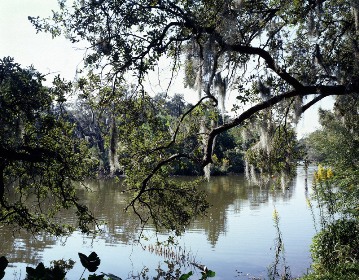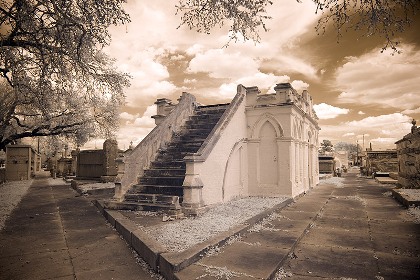Influenced by French colonization, jazz culture, and Cajun cuisine, New Orleans is a unique U.S. city bursting with rhythm and tradition. Although it's best known for music, nightlife, and its Mardi Gras festival, New Orleans also boasts an abundance of history and culture in its historic neighborhoods. Follow this slideshow to learn more about some landmarks that distinguish New Orleans from other American cities.
- City Park

- Founded in 1853, City Park in New Orleans is one of the oldest public parks in the country and ranks sixth in size. City Park offers carousels, storyland, New Orleans Botanical Garden, New Orleans Museum of Art, bandstands, golf courses, athletic facilities, and fountains.
- Fun Fact: City Park features the largest collection of mature oak trees in the country, some are over 600 years old.
![PhotographsAmerica.com Logo (Carol M. Highsmith)]() Find more Carol Highsmith photos on PhotographsAmerica.com. Carol Highsmith, a distinguished and widely published American photographer, is donating her life's work to the Library of Congress.
Find more Carol Highsmith photos on PhotographsAmerica.com. Carol Highsmith, a distinguished and widely published American photographer, is donating her life's work to the Library of Congress.
- Doullut Steamboat House
![Carol Highsmith photo]()
- Captain Milton Doullut was a riverboat pilot who built the first steamboat house in 1875. Steamboats were a major source of cargo and passenger transportation on the Mississippi river in the 19th century. The Doullut steamboat house resembles traditional water-going steamboats with porthole-style windows, upper and lower galleries, and ironwork trim.
- Fun Fact: Doullut's son built a twin steamboat house on the same street.
- Mardi Gras
![Carol Highsmith photo]()
- A festival celebrated in Europe since Medieval times, Mardi Gras, meaning Fat Tuesday in French, was introduced to the United States by French settlers in the 19th century. Mardi Gras is celebrated in New Orleans every year on the day before Ash Wednesday. Mardi Gras is the last day of Carnival festivities, and the last day before Lent begins. Purple, green, and gold, which symbolize justice, faith, and power respectively are the official colors of Mardi Gras. Today, celebrations include parades, costumes, kingcakes, beads, and music.
- Fun Fact: The flambeaux carriers, who carry torches to light the way for parade floats, were originally slaves and free men of color. Today, flambeaux carriers are considered world-class performance artists.
- Jackson Square
![Carol Highsmith photo]()
- Jackson Square is a famous historic area in the heart of New Orleans's French Quarter, and a favorite venue of street artists and musicians. Originally named Place d'Armes, the area was renamed Jackson Square after the Battle of New Orleans in 1814 to honor General Andrew Jackson. A statue of Jackson has stood in the center of the square since 1856. St. Louis Cathedral, the Cabildo, and the Jax Brewery building are some of the famous structures found within the square. As a part of the French Quarter, Jackson Square has been a National Historic Landmark since the 1960s.
- Fun Fact: Jackson Square was originally a park known as the Place d' Armes.
- French Quarter
![Carol Highsmith photo]()
- The French Quarter is the oldest and most famous part of New Orleans. Settled in 1718 by Jean Baptiste Lemoyne de Bienville, the French Quarter was the center of New Orleans called Vieux Carre, meaning "Old Square" in French. There is a mélange of French, Spanish, and Anglo-American architectural styles within the quarter, and strict zoning laws are in place to preserve the historic look and feel of the area. Some of the famous sites within the French Quarter include Jackson Square, the French Market, and Bourbon Street.
- Fun Fact: The Caf� du Monde, where hungry patrons can feast on beignets and caf� au lait spiced with chicory 24 hours a day, is located in the French Quarter.
- Cities of the dead
![Carol Highsmith photo]()
- There are 42 cemeteries in New Orleans, 90% of which have above-ground tombs. St. Peter's cemetery in the French Quarter was the first cemetery built in New Orleans. Coffins placed under the ground resulted in watery graves. Due to the high water table in New Orleans, graves dug even a few feet below the ground would be soaked by water and sometimes floated back to the surface. After several epidemics in the 19th century, the city mandated above-ground graves. Graves were built above-ground in street-like formation, giving the cemeteries their nickname "cities of the dead."
- Fun Fact: St. Peter's cemetery in the French Quarter was the first cemetery built in New Orleans.
- St. Louis Cathedral
![Carol Highsmith photo]()
- Named after St. Louis, King of France, the Cathedral was first built when French settlers arrived in New Orleans in 1718. Much of the original church was destroyed in the great fire of 1788. Despite damage from a bomb and hurricanes over two centuries, the current structure has stood since 1794. St. Louis Cathedral is the oldest continuously operating cathedral in the United States. Located in the Place John II in the historic French Quarter, St. Louis Cathedral is the seat of Roman Catholic Archdiocese of New Orleans.
- Fun Fact: St. Louis Cathedral is the oldest continuously operating cathedral in the United States.
- Bourbon Street
![Carol Highsmith photo]()
- Originally a high-end residential street in the center of New Orleans, Bourbon Street was named for the French Royal family, the House of Bourbon. During the early twentieth century bars and night clubs started to open on upper Bourbon Street. The many bars, night clubs, cabarets, restaurants, and souvenir shops make Bourbon Street one of the most popular attractions in News Orleans-it is crowded with thousands of people during Mardi Gras festivities.
- Fun Fact: Galatoire's Restaurant, which opened in 1905, on Bourbon Street is one of New Orleans' oldest and most popular restaurants.
- Canal Street
![Carol Highsmith photo]()
- Originally intended to be a canal, the aptly named Canal Street was dug wider than other streets. Canal Street, which was never used as a canal, became a physical and symbolic divider in New Orleans, separating the Creole Vieux Carre from the new American borough, which is now the business district. Canal Street has undergone many changes—shifting from a residential district to a commercial one, from a grassy promenade to a five track railway, and finally to a boulevard of music halls, theaters, restaurants, and hotels. Throughout the changes music has been a constant theme on Canal Street, as in the rest of New Orleans.
- Fun Fact: Canal Street is the widest main street in the United States.
- Jazz Fest
![Carol Highsmith photo]()
- New Orleans's Jazz Fest is a tribute to city's legacy as the birthplace of jazz. A spontaneous concert by Duke Ellington and Mahalia Jackson at the 1970 Heritage Festival in New Orleans initiated what is known as "Jazz Fest" today. By 2001, the internationally known event included 12 stages, over 650,000 attendees, and performers such as Aretha Franklin, Miles Davis, Bob Dylan, and Ella Fitzgerald. Jazz Fest continues to grow in popularity celebrating not only jazz music, but gospel, blues, R&B, rock, funk, African, Caribbean, folk, and much more.
- Fun Fact: In its first year only 350 people attended the Congo Square event. By 1975, 80,000 people gathered on a 145 acre site for three days.

![PhotographsAmerica.com Logo (Carol M. Highsmith)]() Find more Carol Highsmith photos on PhotographsAmerica.com. Carol Highsmith, a distinguished and widely published American photographer, is donating her life's work to the Library of Congress.
Find more Carol Highsmith photos on PhotographsAmerica.com. Carol Highsmith, a distinguished and widely published American photographer, is donating her life's work to the Library of Congress.![Carol Highsmith photo]()
![Carol Highsmith photo]()
![Carol Highsmith photo]()
![Carol Highsmith photo]()
![Carol Highsmith photo]()
![Carol Highsmith photo]()
![Carol Highsmith photo]()
![Carol Highsmith photo]()
![Carol Highsmith photo]()











